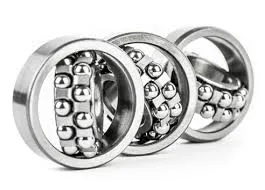
Nov . 17, 2024 00:42 Back to list
metric taper roller bearings
Understanding Metric Taper Roller Bearings
Metric taper roller bearings are essential components in various mechanical systems, widely utilized in industries ranging from automotive to aerospace. Unlike standard ball bearings, taper roller bearings are designed to handle heavy radial and axial loads thanks to their unique geometry. This article will explore the structure, advantages, applications, and maintenance of metric taper roller bearings.
Structure and Design
Metric taper roller bearings consist of an inner ring, outer ring, tapered rollers, and a cage. The inner and outer rings are conically shaped, allowing the rollers to nestle between them at an angle. This design enables the bearings to accommodate large axial loads while simultaneously supporting radial loads. The metric specification indicates that the dimensions, including bore size and outer diameter, are described in millimeters, making them compatible with international standards.
The tapered rollers are arranged in a way that the lines of action of the load converge at a single point on the bearing axis. This characteristic reduces stress on the individual rollers and enhances load distribution, contributing to improved durability. The internal geometry of taper roller bearings allows for reduced friction during operation, which is crucial for high-speed applications.
Advantages of Metric Taper Roller Bearings
1. High Load Capacity One of the primary advantages of metric taper roller bearings is their ability to handle high loads. The tapered design maximizes the contact area, enabling them to support significant radial and axial forces. 2. Versatility These bearings can be utilized in a variety of machines and applications, making them versatile components in engineering designs. From automotive wheel hubs to industrial machinery, their adaptability is a key benefit.
3. Enhanced Durability Taper roller bearings are generally designed for longevity. The quality of materials used in their construction ensures resistance against wear, while proper maintenance can further enhance their service life.
4. Reduced Vibration The design of taper roller bearings contributes to minimal vibration levels during operation. This feature is particularly valuable in precision applications where stability and smooth operation are critical.
metric taper roller bearings

Applications
Metric taper roller bearings find their applications in numerous sectors. In the automotive industry, they are commonly used in wheel hubs, transmission units, and differential systems, providing smooth and reliable performance. In manufacturing, taper roller bearings support heavy machinery and conveyors, ensuring that operations run efficiently.
Additionally, these bearings are employed in agricultural equipment, construction machinery, and even in aerospace applications. Their ability to withstand extreme conditions and heavy loads makes them a favored choice in high-stress environments.
Maintenance and Care
To ensure the proper functioning of metric taper roller bearings, regular maintenance is essential. This includes monitoring for signs of wear and tear, ensuring adequate lubrication, and conducting periodic inspections. The lubrication helps reduce friction and prevents overheating, which can lead to premature failure.
It’s crucial to follow the manufacturer’s guidelines regarding installation and maintenance procedures. Proper alignment during installation can prevent unnecessary wear, while regular cleaning can help maintain optimal performance. Additionally, replacing worn-out components in a timely manner is vital to prevent extensive damage to the machinery.
Conclusion
In conclusion, metric taper roller bearings are fundamental elements in modern engineering, providing a robust solution for applications requiring high load capacity and durability. Their unique design allows for effective performance across a wide range of industries, making them indispensable in both mechanical and structural applications. Understanding their features, advantages, and maintenance practices empowers engineers and technicians to leverage these critical components effectively, ensuring the longevity and reliability of the machinery they support.
Latest news
-
Premium Deep Groove Ball Bearings | High Speed & Reliability
NewsAug.29,2025
-
Durable Scaffolding Clamps - Secure & Reliable Tube Connectors
NewsAug.28,2025
-
Common Failures in Thrust Ball Bearings and Solutions
NewsAug.22,2025
-
How Tapered Roller Bearings Can Take Shock Loads
NewsAug.22,2025
-
Angular Bearings in High-Precision Spindles
NewsAug.22,2025
-
The Impact of Misalignment on Cylindrical Roller Bearing Performance
NewsAug.22,2025
